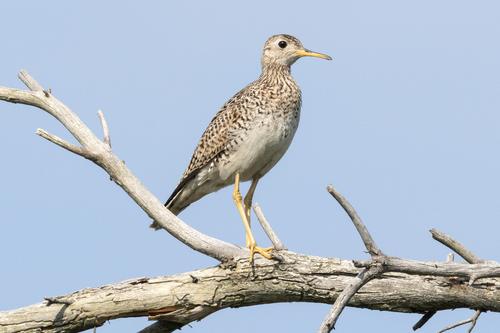Plants and Animals
Bartramia longicauda Upland sandpiper
Key Characteristics
The upland sandpiper is a medium-sized terrestrial shorebird approximately 12 in (30 cm) in length, with a wingspan of 20 in (51 cm). It has a small dove-like head, on a thin neck, with a distinctive large, dark eye. In flight, its dark primaries contrast with the lighter and mottled brown of the rest of its wings and back. Its tail is long, proportionally the longest of all North American sandpipers, and its yellowish legs do not protrude beyond the tail in flight. Other field marks include a white eye ring, and short yellow bill with a black tip. Song is an ascending whistled chatter, followed by a wolf-whistle.
Status and Rank
US Status: No Status/Not Listed
State Status: T - Threatened (legally protected)
Global Rank: G5 - Secure
State Rank: S3 - Vulnerable
Occurrences
| County | Number of Occurrences | Year Last Observed |
|---|---|---|
| Crawford | 4 | 2025 |
| Kalkaska | 1 | 2025 |
| Montmorency | 1 | 2024 |
| Oscoda | 1 | 2024 |
| Otsego | 1 | 2024 |
Information is summarized from MNFI's database of rare species and community occurrences. Data may not reflect true distribution since much of the state has not been thoroughly surveyed.
Habitat
Uplands sandpipers use a variety of open habitats, including prairies, pastures, wet meadows, barrens, and croplands.
Natural Community Types
For each species, lists of natural communities were derived from review of the nearly 6,500 element occurrences in the MNFI database, in addition to herbarium label data for some taxa. In most cases, at least one specimen record exists for each listed natural community. For certain taxa, especially poorly collected or extirpated species of prairie and savanna habitats, natural community lists were derived from inferences from collection sites and habitat preferences in immediately adjacent states (particularly Indiana and Illinois). Natural communities are not listed for those species documented only from altered or ruderal habitats in Michigan, especially for taxa that occur in a variety of habitats outside of the state.
Natural communities are not listed in order of frequency of occurrence, but are rather derived from the full set of natural communities, organized by Ecological Group. In many cases, the general habitat descriptions should provide greater clarity and direction to the surveyor. In future versions of the Rare Species Explorer, we hope to incorporate natural community fidelity ranks for each taxon.
Management Recommendations
Protect and maintain large (> 100 ha) tracts of grassland or open land habitat. Vegetation management activities (mowing, controlled burns, and brush clearing) are recommended to set back succession and maintain habitats, but these activities should be conducted in the fall (Oct and Nov) after migration. All areas of suitable habitat should not be disturbed in a single season. Burning or mowing of habitats should occur on a rotational basis, ideally every 2-4 years, to create a diversity of habitat types and provide undisturbed patches of habitat for nesting. Herbicide and insecticide applications should be avoided during the nesting season. Potential display perches such as fence posts, rock piles, or tree stumps should be retained or provided.
Active Period
Migration from first week of April to fourth week of April
Migration from fourth week of July to fourth week of September
Nesting from fourth week of April to fourth week of June
Survey Methods
Surveys are most successful when conducted during the early breeding season prior to incubation, when conspicuous flight and song displays are most common.
Transect, point counts
Survey Period: From fourth week of April to fourth week of June
Time of Day: Morning (sunrise)
References
Survey References
- Bibby, C.J., N.D. Burgess, and D.A. Hill. 1992. Bird Census Techniques. Academic Press, New York.
Technical References
- Ng, A. M. B., and A. P. Kortenhoven. 2025. Species Abstract for Bartramia longicauda (upland sandpiper). Michigan Natural Features Inventory, Lansing, Michigan, USA.


